MARIANI’S
April
25,
2010
NEWSLETTER
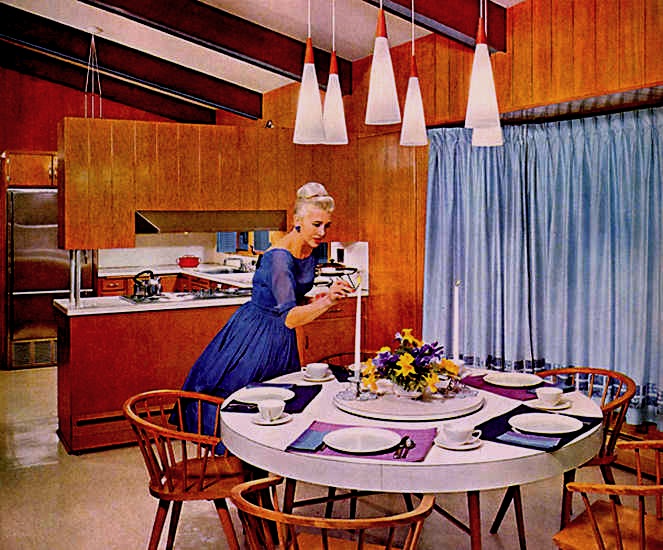
The Modern Dining Room. circa 1965
➔ QUESTIONS? TO REACH JOHN MARIANI WRITE TO: newsletter@johnmariani.com.
➔ ARCHIVE: Readers may now access an Archive of all past newsletters--each annotated--dating back to July, 2003, by simply clicking on www.johnmariani.com/archive
➔ SUBSCRIBE AND
UN-SUBSCRIBE: You may subscribe anyone you wish
to this newsletter--free of charge--by
clicking here.
GOOD
NEWS! Starting this Monday, Esquire.com
will have a new food section on its site, called "Eat Like a
Man," which will be featuring restaurant articles by John Mariani from
around the USA.
~~~~~~~~~~~~~
☛ In
This Issue
DINING OUT IN VIENNA by John Mariani
NEW YORK CORNER:
The Oak Room at
The Plaza by
John Mariani
by John Mariani
QUICK BYTES
~~~~~~~~~~~~~
DINING OUT
IN VIENNA
by John Mariani
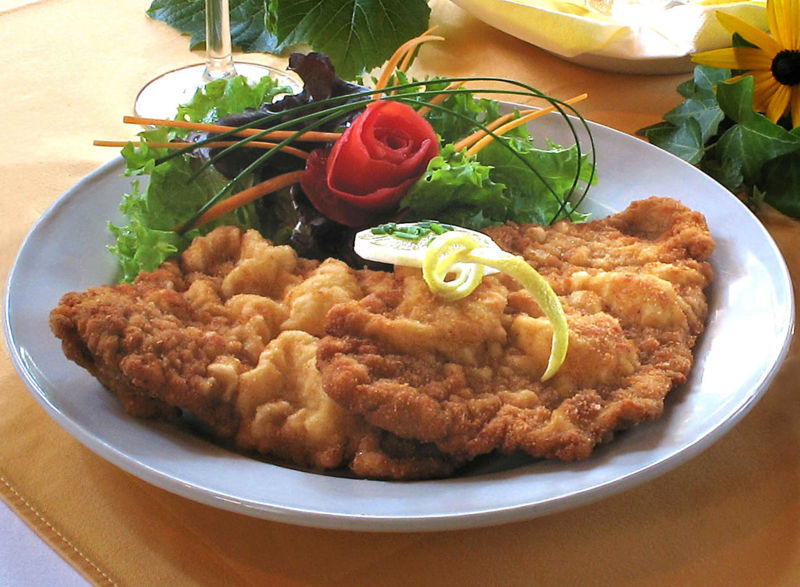
The
appetite-inducing
dish
you
see
above
is
Wiener Schnitzel,
the
namesake
signature
dish
of Vienna, even though there's a
back-and-forth battle with Milan as
to which came first, the veal Wiener
Schnitzel or the costoletta
alla
milanese,
both made from pounded, breaded veal sautéed till
very
crisp. I need not join that battle, for both are simple dishes, which,
when prepared with care, are among the most delicious in Europe. (Odd
that the French never tried to finesse the idea.)
Vienna is an
international city where the locals can pretty much dine out on
any kind of cuisine they like--sushi included--but the traveler is of
course
going to want to taste Austrian cuisine at its best and most typical,
an easy
enough accomplishment because Vienna is justifiably proud of its
cooking, and Wiener Schnitzel is something that
every non-sushi restaurant serves. On my recent trip to Vienna
with an old friend, we went through our share of Wiener Schnitzels, finding all of
them well rendered but none of them so surpassingly great that one
need worry about finding a "quintessential" version. You
really can't go to far wrong.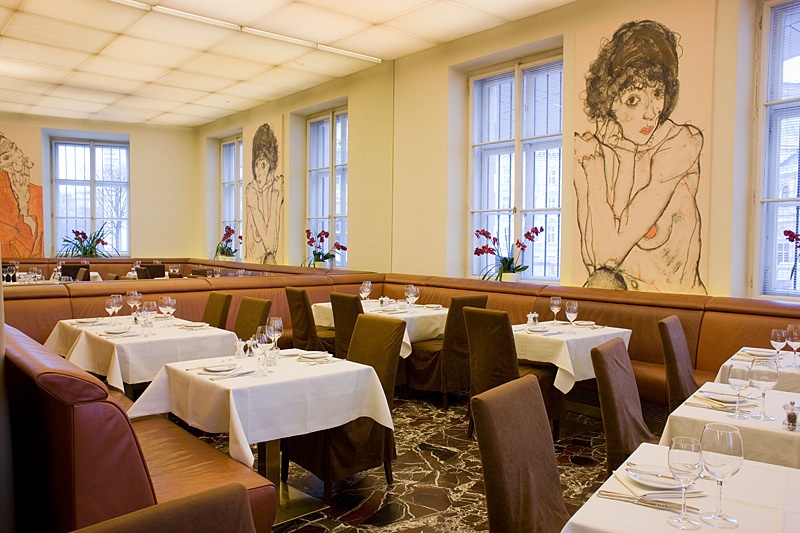
In fact, my friend ate Wiener Schnitzel at least
four times in seven days and I twice, and we were never disappointed,
although Figlmüller is
most famous restaurant for its version and packs people in
for just that dish all day and night.
Our first meal upon arrival
in the city was at Do & Co
Albertina (right),
located within the Albertina Museum in city center. This is a
pretty cool and lively spot, with its Egon Schiele blow-up murals,
good soft leather banquettes, and bright sunshine streaming through the
windows--yet another example of Europe's commitment to good restaurants
in their museums. (Do & Co is a restaurant group that has others
around town.)
So I sat down to my first Wiener Schnitzel squirted it with
lemon, and was blissfully happy with its
crisp,
satisfying flavor of veal lightly fried and served with a
potato-cucumber salad. I also enjoyed the Austrian-style ham
called Schinkenfleckerl with
a steamy, caramelized noodle gratin and green salad,
and a rare tuna steak with a very non-Austrian balsamic and teriyaki
sauce, ratatouille and buttered potatoes mousseline, all accompanied by
a fresh 2008 Blaufrankisch from the Leo Hillinger estate. For
dessert we had their specialty--Mohr
in Hamt, a dense, moist chocolate cake and treacle with
vanilla
ice cream. Prices here were very reasonable, with the main
courses
€13.80-23.50.
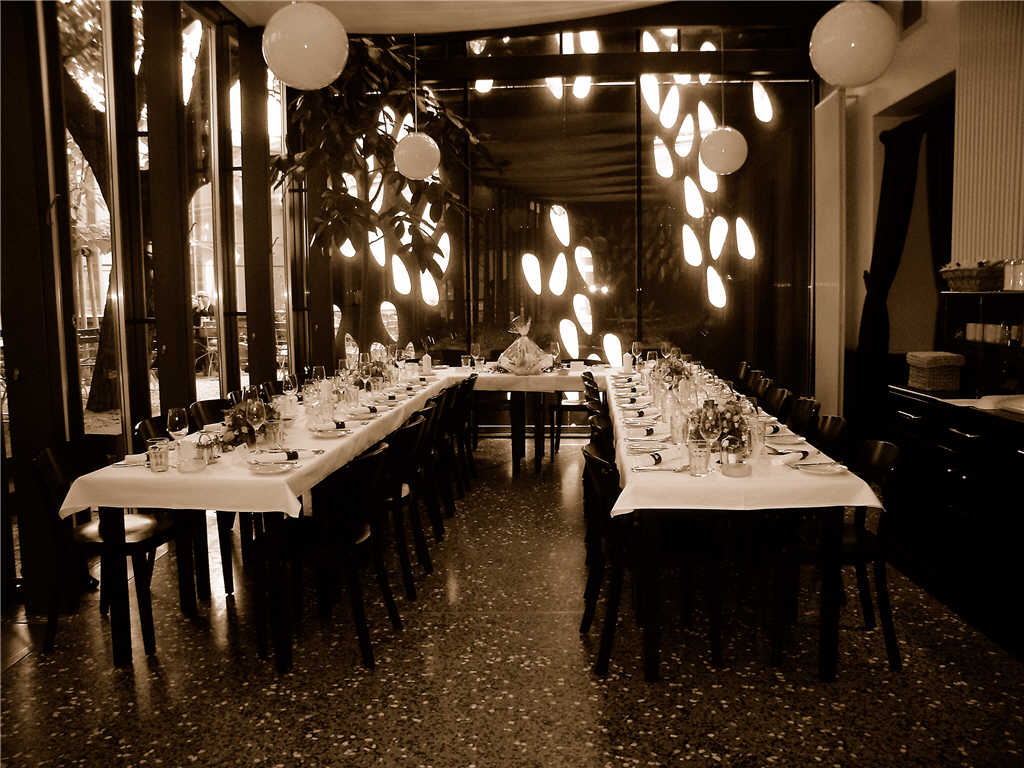 That
evening,
with
snow
blanketing
the
streets, we tromped our way to an
upstairs restaurant at the Museum Platz near the Ringstrasse
named Glacis Beisl (left), through World
War I a canteen, now a popular spot specializing
in traditional and
contemporary Viennese cuisine, in a shadowy dining room
with canvas ceiling, and art nouveau lighting. Begin here with a
glass of sparkling Welschriesling with apricot or pear pulp in
elderfower syrup
while you decide among dishes like leek pumpkin strüdel with herbs
and cream
or marinated beef salad with pumpkins seed oil. A warming beef
consommé with tiny dumplings was perfect fto shun the chill of
the winter's night. For main courses I was
quite happy with juicy roast pork with cabbage and dumplings--a hefty
platter--and roast saddle of veal with a mushroom ragoût, potato
rösti
and vegetables, ending off with churd cheese dumplings and apple puree
and a sugared pancake with stewed
plums.
That
evening,
with
snow
blanketing
the
streets, we tromped our way to an
upstairs restaurant at the Museum Platz near the Ringstrasse
named Glacis Beisl (left), through World
War I a canteen, now a popular spot specializing
in traditional and
contemporary Viennese cuisine, in a shadowy dining room
with canvas ceiling, and art nouveau lighting. Begin here with a
glass of sparkling Welschriesling with apricot or pear pulp in
elderfower syrup
while you decide among dishes like leek pumpkin strüdel with herbs
and cream
or marinated beef salad with pumpkins seed oil. A warming beef
consommé with tiny dumplings was perfect fto shun the chill of
the winter's night. For main courses I was
quite happy with juicy roast pork with cabbage and dumplings--a hefty
platter--and roast saddle of veal with a mushroom ragoût, potato
rösti
and vegetables, ending off with churd cheese dumplings and apple puree
and a sugared pancake with stewed
plums.
The next day, we visited what is
perhaps the most renowned of Vienna's fine dining restaurants, Steiereck in the State Park, set
right by the Vienna River. The three-star restaurant here will
run you €95 for five courses, though there is also an à la
carte menu. We chose to eat in the restaurant's far more casual, very
pretty, very
airy, glass-enclosed Meierei ("Milk
Bar"),
open since 2005, which alludes to its serving milk-based
products at breakfast, only to its fine selection of 150 cheeses.
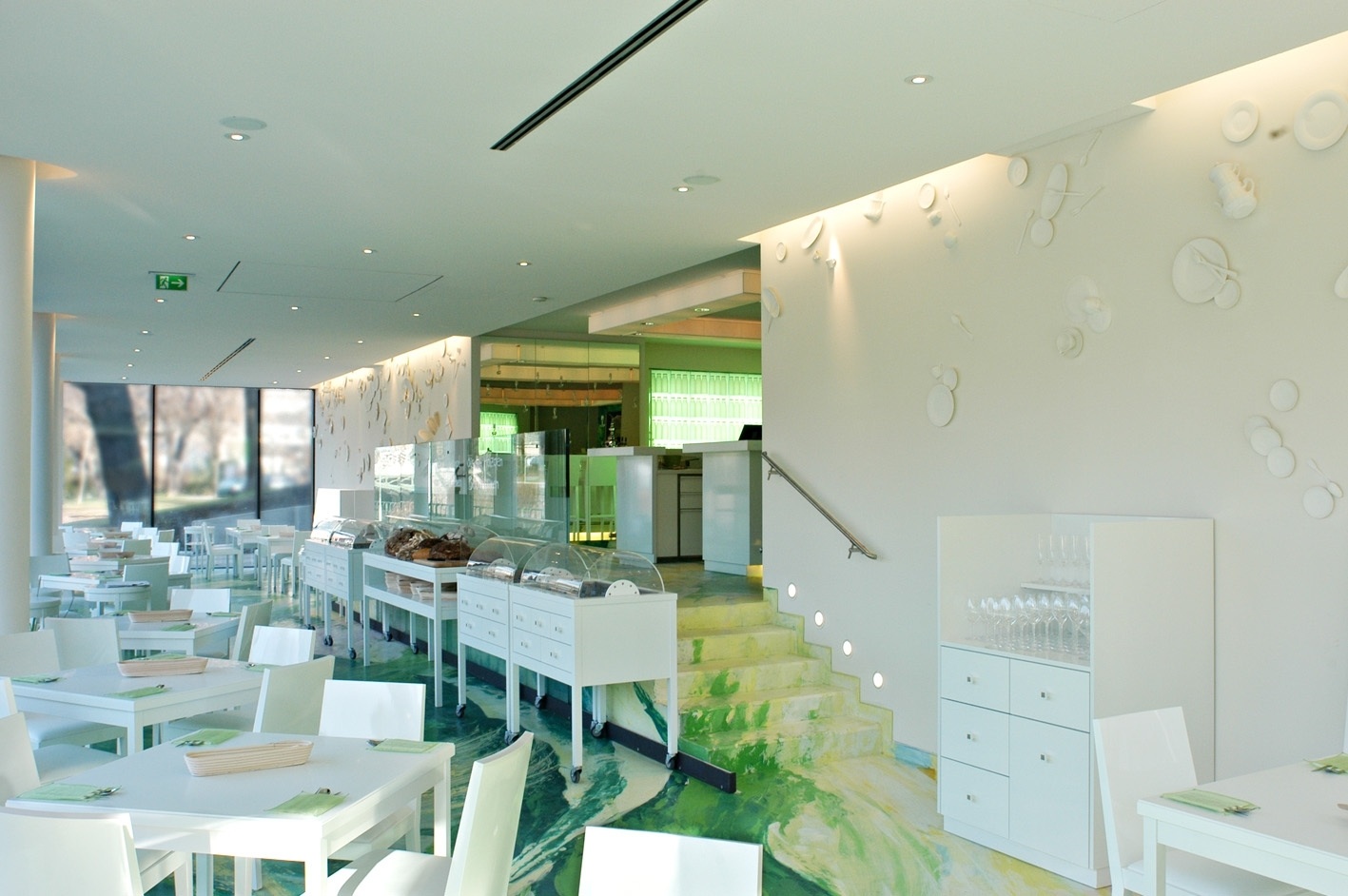 At lunch the bright white restaurant (right) serves more
substantial fare, though always with a lighter touch. It serves
breakfast till noon then stays open till 11 PM.
At lunch the bright white restaurant (right) serves more
substantial fare, though always with a lighter touch. It serves
breakfast till noon then stays open till 11 PM.
One of those light specials is the
hochzeitssuppe, or
“wedding soup,” a deep golden beef bouillon with a crispy strudel, a
bacon biscuit and a semolina dumpling. Wiener Schnitzel here is
first-rate.
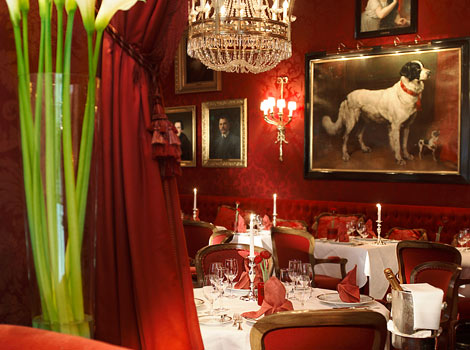 Wiener Schnitzel,
of course, with parslied potatoes, but
for a change of pace I tried the similar Wiener
Backhander, made with pounded, battered chicken, served with
lamb's
lettuce salad. There is also a crackling good suckling veal with its
filet and cheek, served with a carrot confit and polenta.
Wiener Schnitzel,
of course, with parslied potatoes, but
for a change of pace I tried the similar Wiener
Backhander, made with pounded, battered chicken, served with
lamb's
lettuce salad. There is also a crackling good suckling veal with its
filet and cheek, served with a carrot confit and polenta.For dessert it is almost mandatory to feast on the hotel's signature Sacher Torte, which is truly one of the world's finest chocolate layered cakes. Main courses at the Rote Bar run €20-32. The winelist is excellent, rich in Austrian bottlings as well as international selections.
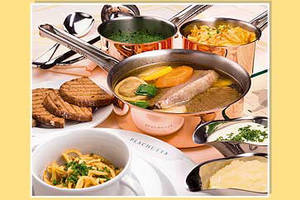 The next day I was determined to find a
superlative Tafelspitz--the
boiled meats and vegetable dishes that is
another of Austria and Germany's classic homestyle dishes, similar to
France's pot au feu and
Italy's bollito misto.
Everyone in town has his favorite places to go for the dish but the
hands-down winner in overall votes is the multi-unit Plachutta.
The
one
we dined at, near the cathedral area, on Wollzeile Street, was
packed, all three big rooms, with wainscoting, yellow tablecloths, and
metal warming plates on which to set and serve the simmering Tafelspitz (right), which is offered in several
versions listed on the menu, so you can pick your selection of
Austria-raised meats--shoulder, ox tongue, brisket, and so on--or the
classic version with Huferschwanzel (from
the
rump),
which comes with sour cream, horseradish, and other
condiments. The hot broth is served first with fresh noodles,
then the slices of meats, with some spinach and crisp, buttery spaetzle potatoes. Main courses run
€15.80-25.40.
The next day I was determined to find a
superlative Tafelspitz--the
boiled meats and vegetable dishes that is
another of Austria and Germany's classic homestyle dishes, similar to
France's pot au feu and
Italy's bollito misto.
Everyone in town has his favorite places to go for the dish but the
hands-down winner in overall votes is the multi-unit Plachutta.
The
one
we dined at, near the cathedral area, on Wollzeile Street, was
packed, all three big rooms, with wainscoting, yellow tablecloths, and
metal warming plates on which to set and serve the simmering Tafelspitz (right), which is offered in several
versions listed on the menu, so you can pick your selection of
Austria-raised meats--shoulder, ox tongue, brisket, and so on--or the
classic version with Huferschwanzel (from
the
rump),
which comes with sour cream, horseradish, and other
condiments. The hot broth is served first with fresh noodles,
then the slices of meats, with some spinach and crisp, buttery spaetzle potatoes. Main courses run
€15.80-25.40.
I
have to admit that after a breakfast the next
day of a bratwurst and hot coffee from a wurst stand parked just
outside the Sacher, I began craving Italian food, and when I heard that
the Antinori family of Tuscany, which makes some of Italy's finest
wines, had a branch of their Florence-based Cantinetta
Antinori
in Vienna (there are others in Moscow and Zurich), we
were ready to
depart from our Austrian diet, rewarded with delicious, plump and
tender gnocchi with 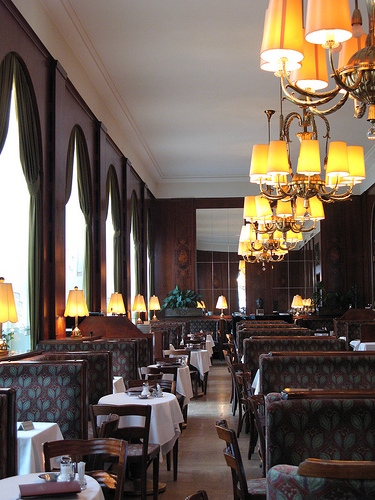 sausage
and
the
tubular pasta cannelloni, followed
by a simply grilled branzino
graced with olive oil and lemon, and two
glasses of Roero Arneis white wine--a good, sturdy but light meal for a
cold afternoon of museum visits. Main courses run €22.50-28.
sausage
and
the
tubular pasta cannelloni, followed
by a simply grilled branzino
graced with olive oil and lemon, and two
glasses of Roero Arneis white wine--a good, sturdy but light meal for a
cold afternoon of museum visits. Main courses run €22.50-28.
Café culture in Vienna is
as important to the local lifestyle as its music. Indeed, there are
said to be 2,200 coffee houses in the city, which must work out to one
on every corner. People go in the morning, have a rather
leisurely breakfast, read the papers, and even claim their tables and
waiters--addresesed as "Herr,"
at their favorites. Some of the best known cafés would
include the one at the Sacher Hotel near the Opera; Café Landtmann (left), which opened in 1873; the Prückel;
Schwarzenberg, and others, each
with its own style and atmosphere, some quieter than others, some for
young people, others for an older crowd that values the afternoon
coffee and pastry afternoon hiatus that seems to stretch into an hour.
A
few
words about dining out in Vienna: Just about every
restaurant has a menu provided in English. Dress, as
everywhere in Europe these days, is casual, but at the more
traditional restaurants and cafes you will want to dress a bit
conservatively, although bluejeans are everywhere. There is no
smoking allowed inside. Service is unfailingly courteous, and in the
cafés very efficient. You won't wait more than a minute or
two for your order. As for tipping, I got various answers from
various Austrian friends: Many restaurants list a service
charge--usually about 10 .5 percent--on the bill, along with a 10
percent VAT tax; there may also be an old-fashioned cover charge for
bread-and-butter, which can be a hefty €2-3. The best bet
is to ask if service is included and if it is, leave another few Euros;
if not, a 10-15 percent gratuity is acceptable.
To read Part One of this article on Vienna, click here.
`````````````````````````````````````````````
NEW
YORK
CORNER
by John Mariani
 The
Oak Room
The
Oak Room
The
Plaza Hotel
10 Central Park South (at
Fifth
Avenue)
212-758-7777
www.oakroomnyc.com
W hen the
Oak Room re-opened in the
fall of 2008, its timing was hardly propitious. The
renovation of the restaurant, along with the entire Plaza Hotel (now
mostly condos) was done with care,
with the City's Landmarks Commission looking over the architect's
shoulder. And the renown of this fabled hotel should have insured
its success. Since opening in 1907,
designed
by Henry Hardenbergh, with an addition in 1932 by Warren & Wetmore,
the grand hotel combined Edwardian posh with the style of a grand
French
château, offering rooms at the opening for $2.50 a night. How
times have changed.
F. Scott Fitzgerald's novel The Great Gatsby, short stories,
and his own antics while staying at The Plaza gave the stately hotel a
Roaring Twenties raffishness, and later the children's book Eloise at
the Plaza (1965) by Kay Thompson bestowed an urban fantasy upon
the
vast hotel, echoed in the 1990 movie "Home Alone." Indeed, several
movie scenes have been set in the hotel, from Hitchcock's "North by
Northwest" (1959) and "The Way We Were" (1973) to "Plaza Suite" (1971)
and even "Crocodile Dundee" (1986). Along with
the Palace Arms in the Brown Palace in Denver, The Oak
Room at the Seelbach in Louisville, and The French Room at The Adolphus
in Dallas, The Oak Room at the Plaza is one of the last grande dame
restaurants in America.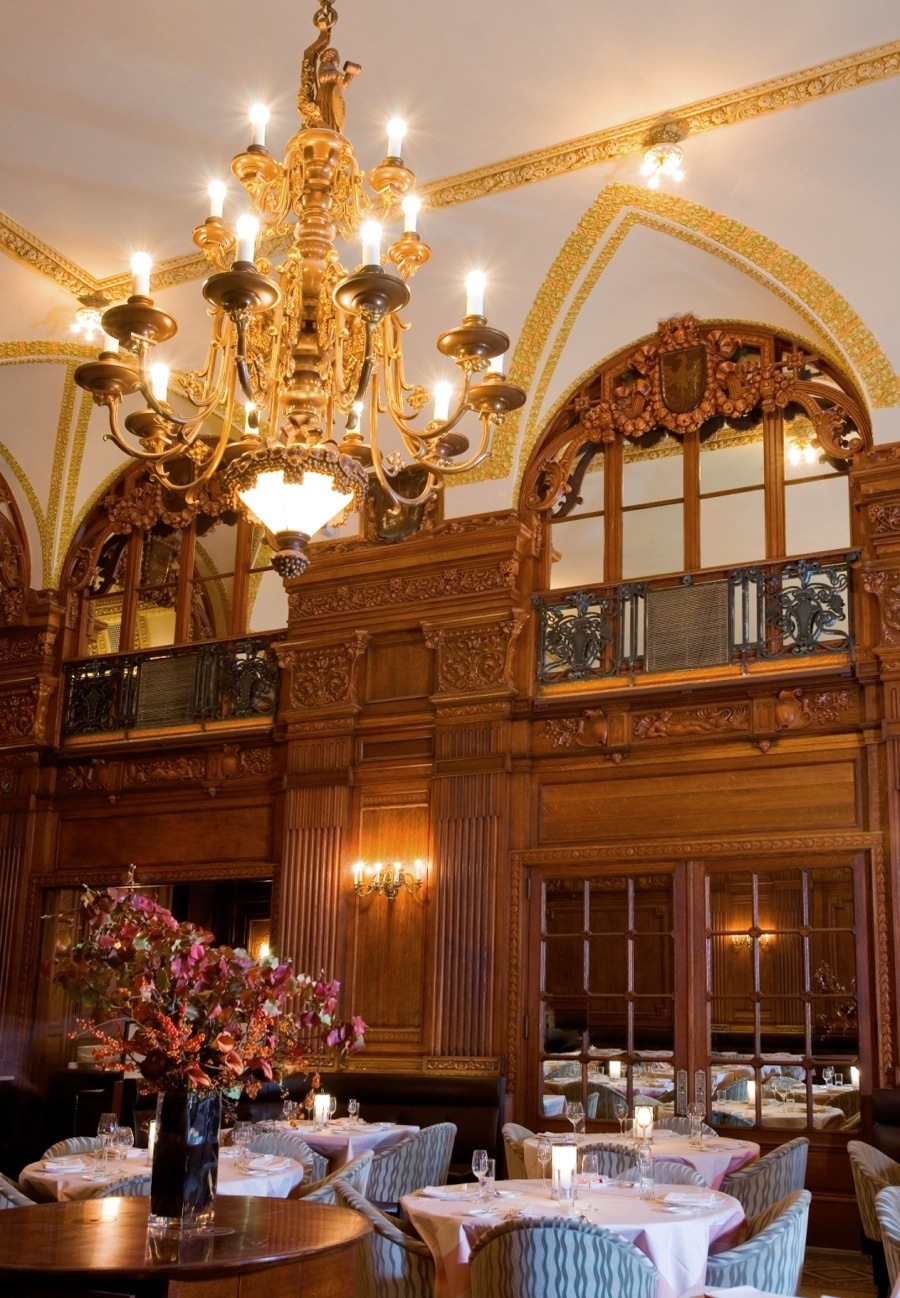
Still, controversy over the
hotel's condo conversions and the onset of the recession made it
difficult for the hotel and The Oak Room to attract the kind of upscale
clientele it was built for, and while French chef Joël
Antunes' cuisine was at the start very fine, the meal was
also very
expensive,
with main
courses $38-$59, and the room's historic trappings overwhelmed
the food.
Some
quick
re-thinking
was necessary; unfortunately, Mr. Antunes was
out within months. In his stead, The Oak Room hired a highly
talented, well-respected American chef named Eric Hara to take
over, put his own stamp on the menu, and try to appeal to a broader
audience. The menu was made fixed price, $55 for three courses
and $70 for four, which in NYC is really quite a steal, and in the
bargain you get the full-tilt glory of The Oak Room.
I may be wrong, but the lighting, once
funereal, seems
better, a little brighter, warmer, and the service is more
professional and amiable. Sad to say, there seems to be no dress
code (the website suggests "smart casual" but many pay no attention to
the first word), and in a place so baronial as this, it's offputting to
see so
many people dressed up along side so many people dressed way down.
The winelist, built up when the
restaurant was re-opened, is now well-suited to the current economics.
It was wonderful to be back in the grand
space of The Oak Room (though the Oak Room Bar is as dark as a
dungeon!), partaking of a real part of Gotham gastronomic
history.
We began with a Scottish langoustine, meaty and sweet, with Ligurian
olives, Marcona almonds and radish, which set up well-conceived
textural contrasts. Beef carpaccio with pickled Japanese
mushrooms
had the lagniappe of rock shrimp tempura and aji amarillo for spice and
that nice little edge of fat. Braised veal cheeks, as a starter,
was hefty and good, with creamy polenta, sweet white peaches, and micro
turnips (these last had little flavor). Two winsome ideas
involved a foie gras "PB&J" with the fresh foie gras on toasted
brioche with a macadamia nut butter and strawberry-vanilla jam--really
good--and "Pork 'n' Beans," which was crisp, meaty pork belly with
smoky tarbais beans and pearl onions.
F
or our main courses, we ordered red snapper with plump Dungeness crab
ravioli, pearl onions and a crab broth with a confit of raisins to add
a sweet touch. Dover sole ($20 supplement) was done simply, with
white asparagus on the side, hedgehog mushrooms and the flavoring of
sorrel--a pleasant dish, but the sole was none too fatty and the dish
needed more butter. 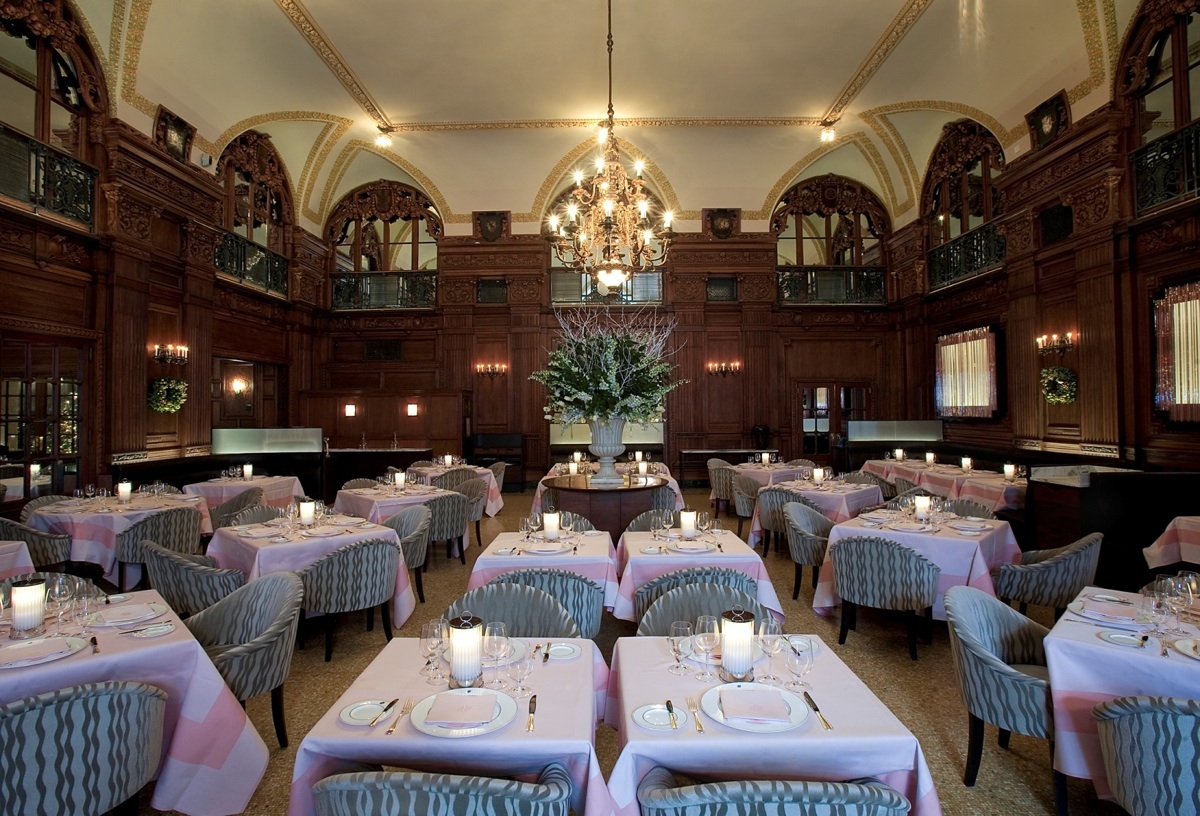 Muscovy
duck
beast
with
a
duck
confit-foie gras cabbage roll, beluga lentils
and white mulberries carried through the leitmotif of savory and sweet
flavors of Hara's cooking, which is never cloying, only
clever. The side dishes of truffled "tater tots" did not,
however,
need the too sweet peach ketchup, but the tempura artichokes with aji
amarillo were delicious.
Muscovy
duck
beast
with
a
duck
confit-foie gras cabbage roll, beluga lentils
and white mulberries carried through the leitmotif of savory and sweet
flavors of Hara's cooking, which is never cloying, only
clever. The side dishes of truffled "tater tots" did not,
however,
need the too sweet peach ketchup, but the tempura artichokes with aji
amarillo were delicious.
You may choose from a selection of cheeses for
$22, or go with pastry chef Mallory Staley's lemon-raspberry Pavolva
with lemon sorbet and rose syrup--quite a lively dish--of the
honest-to-very-goodness caramel apple parfait with warm Milano cookies.
I am hopeful that the revamping of the menu here and
the
improvement in service will bring people back for the occasion to bask
in the radiance of such a glorious room. The food s certainly
worth it at current prices. Now if they could only urge their
make guests to take "smart casual" more seriously, The Oak Room would
again be one of NYC's grandest.
````````````````````````````````````````````````````````````````
NOTES FROM THE WINE CELLAR
Matching
Madeira
to
a
Meal
Makes
More
Sense
Than
Ever
by John Mariani
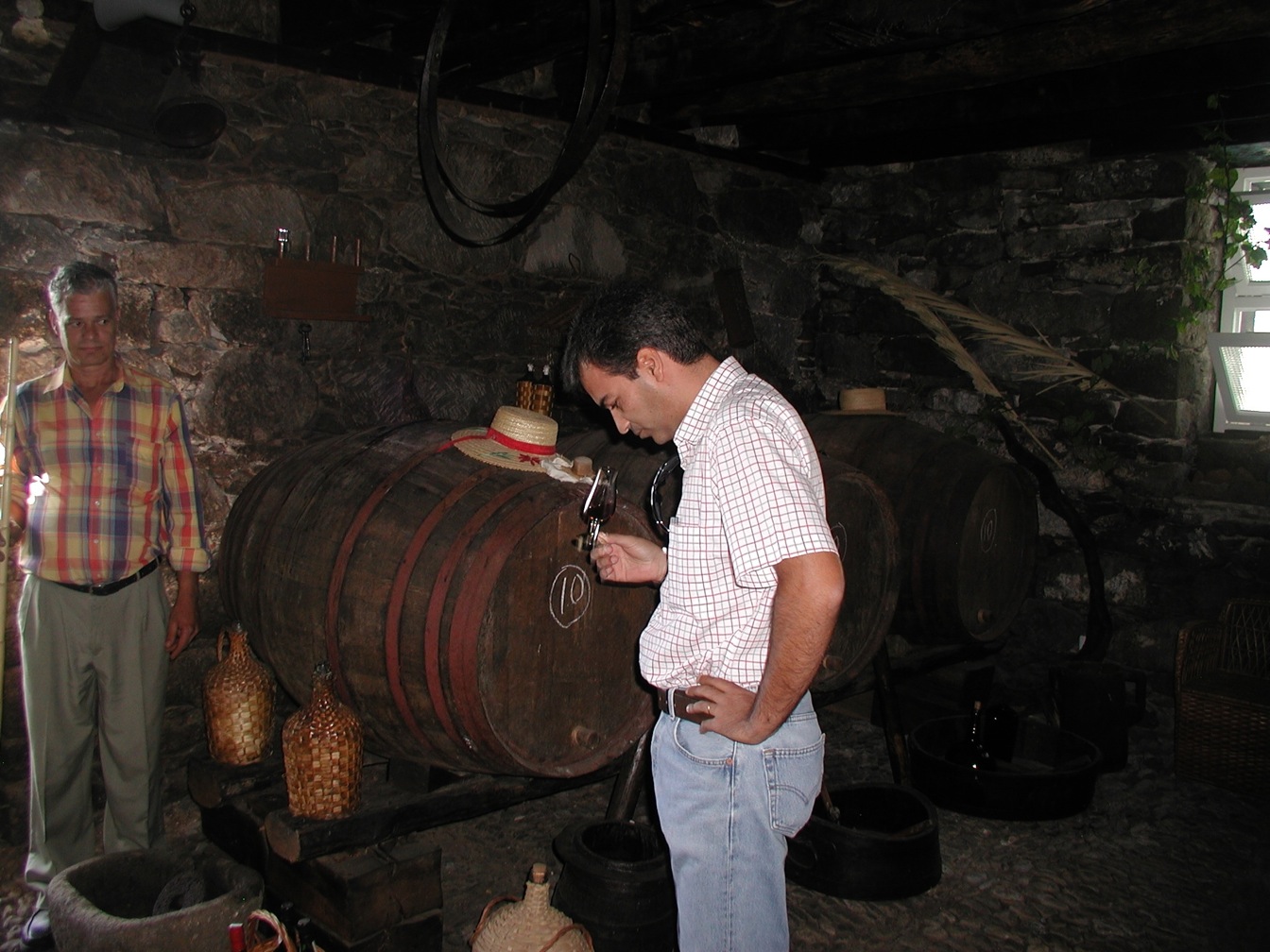
Freitas
is managing director and winemaker for his family’s Viñhos
Barbeito,
whose
Madeiras have twice been judged one of the world’s ten best wines
regardless of
category at Vinexpo in Bordeaux and his basic
10-year-old Verdelho Madeira was judged the top fortified wine in the
world at
Vinexpo, surpassing an array of Vintage Ports. Having tasted half a
dozen of
his wines over lunch, I discovered that not only are they far easier to
drink
than traditional-style Madeiras but that they go far better with food
than as
dessert wines or after-dinner drinks.
One
complete
surprise was to find how well Madeira went with Chef Gabriel Kreuther’s
very
spicy casserole of braised tripe with chickpeas and red hot harissa
aioli--a
dish I would never think of accompanying with a sweet Madeira. But Freitas’ Signature Series Barbeito
VB, a blend of equal parts Verdelho and Boal, was only medium sweet and
the
acid so beloved by Freitas was perfect at cutting the richness of the
dish.
Other
bottlings, like the 2001 Barbeito Boal Colheita Madeira Casks 48+84
($45/500
ml)--those palindromic numbers signaled good fortune to Freitas when he
found
the casks-- went splendidly with a foie gras torchon with dried
cherries and
duck prosciutto, while a duck confit
à l’orange, with its own
bittersweet edge,
was wonderful with the nutty “Charleston” Sercial.
This
last, along with a “Boston” Boal and “New York” Malmsey, these Madeiras
are
part of what Barbeito calls its “Historic Series,” commemorating the
prestigious reputation Madeira had in the 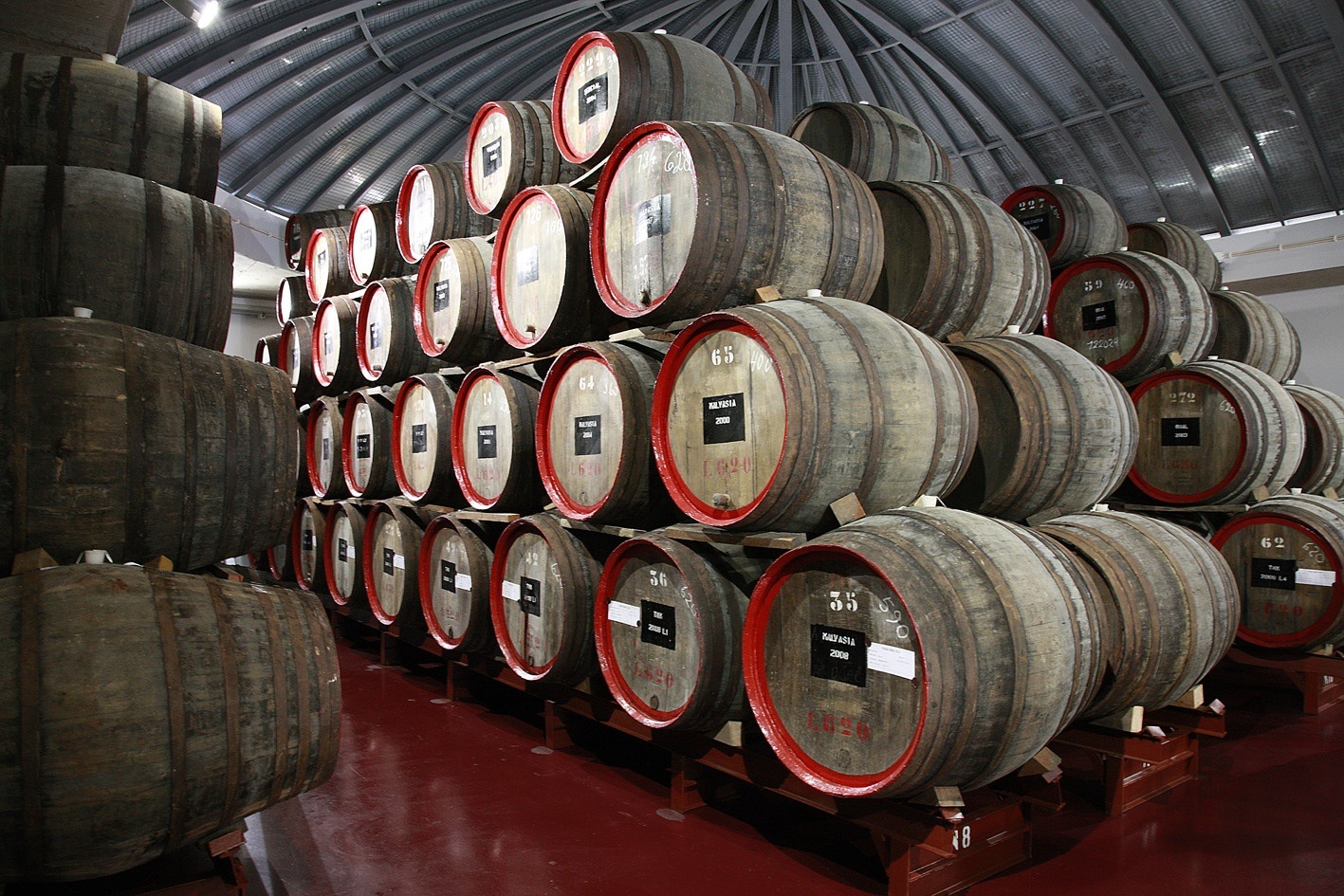 U.S. in the 18th and
19th
centuries.
U.S. in the 18th and
19th
centuries.
Along with the
firm’s American importer, The Rare Wine Co., Barbeito creates its wines
from
single harvest and/or single casks in limited production, with just a
barrel or
two made at a time. Freitas regards each step of the Madeira-making
process,
including fortifying the wine with spirits, as an opportunity for
questioning
old practices. “It took me five years to convince my mother to stop
using
caramel to color the wines,” he says of an age-old technique. “I
believed the
caramel added its own flavor and I wanted the wines to taste only of
their
grape.”
To this end
Freitas
has also demonstrated that Madeira’s workhorse grape Tinta Negra Mole
can make
fine wine without blending, and he ages his wine in a slow method
called
canteiro without the direct heat most producers use in the estufa
(“hothouse”)
method of accelerating the maturation of the wine. Barbeito’s slower
maturation, which keeps oxidation to a minimum, allows the wines to be
enjoyed
earlier and, as I found out over lunch, can be enjoyed with savory food.
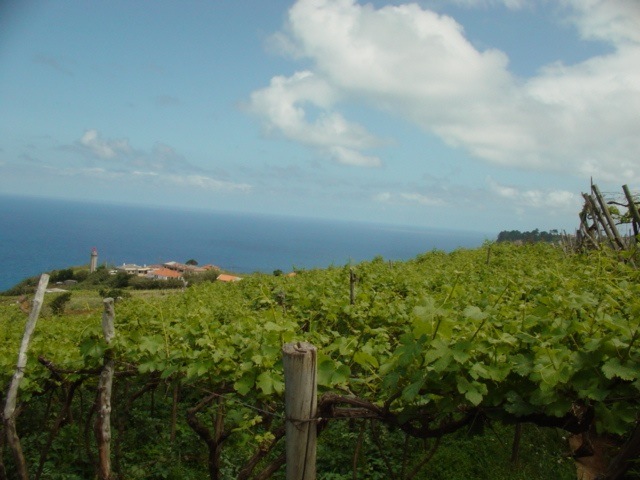 When an age is
indicated on
a Madeira bottle, it usually refers to the oldest wine or the average
age of
the wines in the blend, as with Barbeito
Malvasia 30 year-old Special Lot Madeira ($125/750ml), which
Ricardo
made as a tribute to his grandfather Mario Barbeito, the company’s
founder. The
average age of the wines is 30 years, with some older and some younger.
Freitas
promises this is the only time he will make such a blend; with only
1,550
bottles, it’s the company’s priciest bottling.
When an age is
indicated on
a Madeira bottle, it usually refers to the oldest wine or the average
age of
the wines in the blend, as with Barbeito
Malvasia 30 year-old Special Lot Madeira ($125/750ml), which
Ricardo
made as a tribute to his grandfather Mario Barbeito, the company’s
founder. The
average age of the wines is 30 years, with some older and some younger.
Freitas
promises this is the only time he will make such a blend; with only
1,550
bottles, it’s the company’s priciest bottling.
Barbieto will
also
vintage date the wines to indicate a single barrel Madeira like its 1994 Malvasia Single Cask '23c’ ($50/500ml),
bottled by hand in 2006, with 942 bottles made. In the fall of
2007,
upon finding that a cask from 2000 had become quite concentrated after
the
summer’s heat caused evaporation, he bottled the wine immediately to
maintain
its refinement and richness, which might have been compromised by
further
aging.
We did
enjoy
the Madeiras with some artisanal cheese and desserts like a milk
chocolate and hazelnut dacquoise with raspberry sorbet, which
would have made conventional sense at that point in the meal. But
Freitas, who
seemed as surprised as I was by the match-ups with the first and main
courses,
proved to me the versatility of his wines with food.
I’m not sure I’m ready for an entire meal accompanied only
by Madeira wines—whose alcohol content is 19 percent and higher—but
with an
individual dish, especially one with spice and a little sweetness, they
are
absolutely delicious alternatives to dry whites or reds.
~~~~~~~~~~~~~~~~~~~~~~~~~~~~~~~
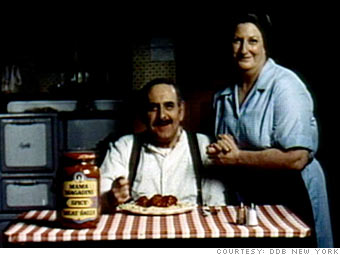
A former NYC
counterterrorism detective named Anthony
Chiofalo says he was
unfairly fired after failing a drug test he blamed on his wife because
she put marijuana in his meatballs. A
state appeals court upheld the dismissal, even though his wife Catherine
told police investigators she secretly substituted marijuana for
oregano in the recipe so that her husband would fail the test so
he would have to leave police
work. But Police
department lawyer Edward Hart says there was more marijuana in
Chiofalo's
system than the meatballs could explain.

THEN GO OUT AND BUY THE GUY A NICE STUDDED COLLAR
Faster Times asked writer
Jessica Pilot to determine which “human-grade” dog food tastes best in
categories that included “something that I would serve my boyfriend
for dinner.” You may watch the video at
http://newyork.grubstreet.com/2010/03/ruff_times_freelance_journalis.html.
````````````````````````````````````````````````````````````````
✉ Guidelines for submissions: QUICK BYTES publishes only events, special dinners, etc, open to the public, not restaurant openings or personnel changes. When submitting please send the most pertinent info, incl. tel # and site, in one short paragraph as simple e-mail text, WITH DATE LISTED FIRST, as below. Thanks. John Mariani
OWING
TO THE NUMBER OF MOTHER'S
DAY-RELATED
EVENT ITEMS SUBMITTED TO THE VIRTUAL
GOURMET, IT IS IMPOSSIBLE
TO INCLUDE ANY BUT THE MOST EXTRAORDINARY.
* From Apr.
15 – June 15 in Milan, Italy, Hotel Principe di Savoia invites guests
to "Name Their Price" at Acanto Restaurant. Each evening, guests have
the opportunity to reserve a single table for a maximum of
4-diners,
ordering from the À La Carte menu.
The final tab will be whatever they
think dinner is worth. The offer incl. multiple courses, soft drinks,
and
coffee; wine and alcoholic beverages will be charged as stated on the
Wine List
and Bar Menu. Rates start at 255 Euro per night. Call
39-02-6230-5555 or visit www.hotelprincipedisavoia.com.
*On
Apr. 22 in NYC, Bistrot Bagatelle will host
its first “Arabian Nights.” Guests can expect costumed
waiters, Middle Eastern décor, Arabic beats by DJ Taze; belly
dancers, and Chef Nicolas Cantrel's i couscous and classic Mezze
style dishes. Call 212-675-2400 or visit
www.bistrotbagatelle.com.
* On Apr. 29, in NYC, the Grand Street Settlement will host the 10th Annual Taste of the Lower East Side at the Puck Building. 40 restaurants from the Lower East Side and surrounding neighborhoods will serve a trademark dish accompanied by special cocktails, beer and wine donated by major beverage sponsors. 100% proceeds benefit Grand Street Settlement’s services for low-income children, youth and families living in the LES and in Bushwick, Bklyn. Tickets $150 pp and can be purchased at grandstreet.org/taste.
* On May 1 in New Orleans, the Southern Food and Beverage Museum will discuss the origin and role of the Mint Julep in the American South. We will demonstrate how to make the traditional version as well as the now-extinct New Orleans style julep. Traditional Kentucky Derby snacks and drinks incl. $15 for members and $20 for non-members. Call 504-569-0405 or email stephanie@southernfood.org
* On May 6 in San Francisco, CA, Moussy’s Restaurant hosts a dinner and cookbook signing showcasing Mireille Guiliano’s latest book, The French Women Don’t Get Fat Cookbook. The author will be present. $85 pp, incl. a copy of the book. Call 415-441-1802. www.moussys.com.
* On May 6, Absinthe Brasserie & Bar
in San Francisco, CA, will
host an intimate dinner with Kermit Lynch. Lynch will
pour selected vintages from two of his benchmark producers – Domaine de
Cherisey and Domaine Les Pallières – paired with a
4-course
menu from Executive Chef Jamie Lauren. $150 pp. Call 415-551-1453.
* This May 8,
sample wines from Oregon's best small
producers
at Portland Indie Wine & Food Festival (Tickets $75, VIP
$125 - call
503-595-0891 or visit www.indiewinefestival.com. Book Hotel Vintage
Plaza's
special "Portland Indie Wine Package" for a VIP ticket upgrade,
overnight room for 2, Oregon Pinot wine flights, Riedel glasses, and
more.
Package prices starting at $229. Book at www.vintageplaza.com. or call
800-263-2305.
* On May 8, in Portland, OR, the Portland Indie Wine & Food Festival returns to at the Bison Building to showcase 40 jury-selected, Oregon craft wineries and 15 of the city's creative culinary talents in a farmer’s market-style setting. $75 pp. VIP tickets are $125. in NE Portland near downtown. Call 503-595-0891, or visit www.indiewinefestival.com.
* On May 13 in San Francisco, at the Old Mint Building, the San Francisco Museum and Historical Society presents Standing Ovations III – Cookin’ The Mint, honoring San Francisco Bay Area culinary luminaries. The Old Mint will transform into a living “Farmer’s Market” with exhibits, featuring stories of chefs, wineries and food purveyors. $500 pp/. Call 415-537-1105 x107, www.sfstandingovations.com.
On May 13, in
Hollywood,
CA, the Bogart Pediatric Cancer Research Program will host its Eighth Annual
Wine Aficionado Dinner at the W Hotel. Titled
“Hollywood and Wine: The
Biggest Stars in Wine Today,” dinner will showcase some of the world’s
finest wines paired with a 4-course dinner. Wine service will be
overseen by
several LA sommeliers. Live auction. $1,250 pp. or $10,000 per
table of ten. Call 323-330-0520.
* The Inn at 202 Dover in Easton, Maryland has just introduced a Sunday Jazz Brunch created by chef Mark Knipp, Music is provided by improvisational Jazz pianist Joe Holt. Guests can also come for the night and receive half off a second night. Visit www.innat202dover.com.
````````````````````````````````````````````````
Everett Potter's Travel Report:

~~~~~~~~~~~~~~~~~~~~~~~~~~~~~~~~~~~~~~~~~~~~~~~~~~~~~~~~~~~~~~~~~~~~~~~~~~
Eating Las Vegas is the new on-line site for Virtual Gourmet contributor John A. Curtas., who since 1995 has been commenting on the Las Vegas food scene and reviewing restaurants for Nevada Public Radio. He is also the restaurant critic for KLAS TV, Channel 8 in Las Vegas, and his past reviews can be accessed at KNPR.org. Click on the logo below to go directly to his site.
~~~~~~~~~~~~~~~~~~~~~~~~~~~~~~~~~~~~~~~~~~~~~~~~~~~~~~~~~~~~~~~~~~~~~~~~~~~
Tennis Resorts Online: A Critical Guide to the World's Best Tennis Resorts and Tennis Camps, published by ROGER COX, who has spent more than two decades writing about tennis travel, including a 17-year stretch for Tennis magazine. He has also written for Arthur Frommer's Budget Travel, New York Magazine, Travel & Leisure, Esquire, Money, USTA Magazine, Men's Journal, and The Robb Report. He has authored two books-The World's Best Tennis Vacations (Stephen Greene Press/Viking Penguin, 1990) and The Best Places to Stay in the Rockies (Houghton Mifflin, 1992 & 1994), and the Melbourne (Australia) chapter to the Wall Street Journal Business Guide to Cities of the Pacific Rim (Fodor's Travel Guides, 1991).

Family Travel
Forum: The
Family
Travel
Forum
(FTF),
whose
motto
is
"Have
Kids,
Still
Travel!",
is
dedicated
to
the
ideals,
promotion
and
support
of
travel
with
children.
Founded
by
business
professionals
John
Manton
and
Kyle
McCarthy with first class travel industry credentials and global family
travel experience, the independent, family-supported FTF will provide
its members with honest, unbiased information, informed advice and
practical tips; all designed to make traveling a rewarding, healthy,
safe, better value and hassle-free experience for adults and children
who journey together. Membership in FTF will lead you to new worlds of
adventure, fun and learning. Join the movement.
All You Need to Know Before You Go
nickonwine: An engaging, interactive wine column by Nick Passmore, Artisanal Editor, Four Seasons Magazine; Wine Columnist, BusinessWeek.com; nick@nickonwine.com; www.nickonwine.com.

MARIANI'S VIRTUAL GOURMET NEWSLETTER is published weekly. Editor/Publisher: John Mariani.
Contributing Writers: Robert Mariani,
John A. Curtas, Edward Brivio, Mort
Hochstein, Suzanne Wright, and Brian Freedman. Contributing
Photographers: Galina Stepanoff-Dargery, Bobby Pirillo. Technical
Advisor:
Gerry McLoughlin.
Any of John Mariani's books below
may be ordered from amazon.com by clicking on the cover image.
 My
newest book, written with my brother Robert Mariani, is a memoir of our
years growing up in the My
newest book, written with my brother Robert Mariani, is a memoir of our
years growing up in the For those of you who don't think of the Robert and I think you'll enjoy this very personal look at our --John Mariani |
 |
 |
 |
 |
 |
 |
© copyright John Mariani 2010
